Back to Main Online Class Page
Welcome
to this month's class instructed by
Ann Caswell has been involved in needlework on many levels. She has experience in retail
and wholesale, and has taught for needlework shops, companies, and guilds
across North America, including Callaway Gardens and NAN at the Greenbrier.
Ann's goal with students is to provide a wealth of information on the variety
of threads available on the market today, recognizing their properties,
and demonstrating how they work in combination with each other. Ann was
Shop Manager for the American Needlepoint Guild, Inc. 1986-1991, after
which she became national president of ANG from 1994 to 1996. She is currently
on the ANG Correspondence Course Faculty.
Fun with the Woven Stitch
Embroidery stitches provide endless opportunity
for variation. One of the pleasures of needlework for me is to play with
a stitch to see how many different effects can be gained by experimenting
with color and thread choice, full to partial coverage of the canvas or
fabric, combination with other objects such as beads, buttons, trims, etc.
I also study the stitch to see how it can be used for depicting realistic
themes as well as geometric designs. This experimentation provides an understanding
and familiarity with the possibilities and limitations of a stitch and
helps to make it a permanent part of your stitching repertoire.
The Woven Stitch can be used for backgrounds and borders, and to depict
rugs, baskets, clothing, meadows, forests, mountains, and any number of
realistic themes. It is helpful to first examine the stitch structure in
order to understand the stitch and its versatility.
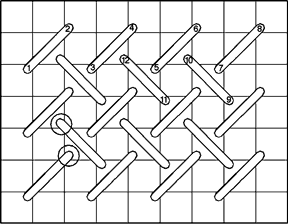
Figure 1 |
| Each individual stitch covers two diagonal intersections
of the fabric or canvas (which we will call "ground" from here
on). Alternate rows slant in opposite directions. It is important to make
sure the placement of the rows is correct (refer to the circles on Figure
1 above) so that the stitches almost tuck under the stitches of the preceding
row. The stitch is usually shown worked horizontally, and it is best worked
starting left to right and working the alternate rows right to left. |
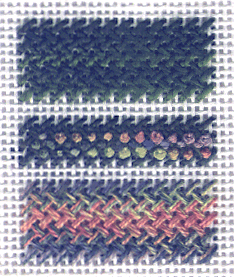
Sample 1 |
The sample above (top) shows horizontal color flow used to suggest grassy
areas by stitching with one strand of Watercolours #065 Emerald on 18 count
Zweigart canvas. The subtle color flow is perfect for grass and leaves.
The sample above (middle) shows the same Emerald Watercolours with one
strand of Wildflowers #088 Mountain Meadow used to make the French Knots
which depict flowers in the meadow. The French knots are stitched between
the Woven stitches.
The same meadow could be depicted by stitching with two strands of Wildflowers
and allowing the color flow of the thread to suggest the random scattering
of flowers across the meadow as shown above (bottom).
Figure 2
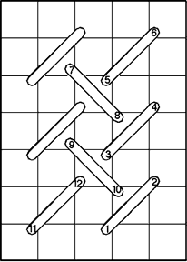
|
Sample 2
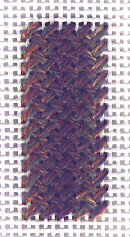
|
If a vertical flow of color is desired (for forests,
mountains, etc.) work the stitches up and down the canvas as shown in Figure
2. In Sample 2 two strands of Wildflowers #047 Camouflage to depict a autumn
woodland scene. |
Sample 3
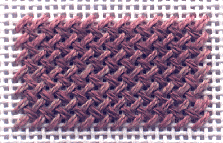
Two different colors and/or threads
can be used to enhance the woven effect of the stitch. In this sample two
strands of Wildflowers #046 Rose Blush are used for the rows slanting to
the right, and two strands of Wildflowers #114 Clove are used for the rows
slanting to the left. |
Sample 4
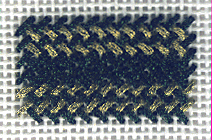 An
elegant look is created by using Antica (a soft and subtle metallic) in
Sample 4 which begins by using one strand of green Antica #AT5 for the rows
slanting to the right and one strand of gold Antica #AT2 for the rows slanting
to the left. In the middle both left and right slanting rows are worked
in the green Antica, and the gold and green rows are reversed for the last
four rows. An
elegant look is created by using Antica (a soft and subtle metallic) in
Sample 4 which begins by using one strand of green Antica #AT5 for the rows
slanting to the right and one strand of gold Antica #AT2 for the rows slanting
to the left. In the middle both left and right slanting rows are worked
in the green Antica, and the gold and green rows are reversed for the last
four rows.
This type of arrangement would make a lovely border on a stocking cuff,
an evening bag, a border for a picture, etc.
|
Figure 3
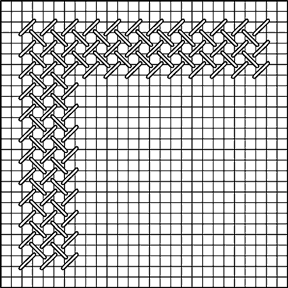
|
Sample 5
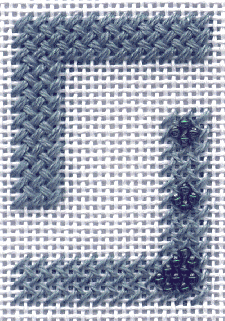
|
| The Figure 3 chart and stitched Sample 5 shows how
versatile the Woven Stitch is for different threads and different grounds.
The top left sample shows two strands of Impressions #7024 worked in a border
(Figure 3). The sample at the lower right shows the same color of Impressions
stitched using only one strand. The lighter coverage can be very effective
and provides an open and lacy look. The areas between the stitches could
be left open or filled in with French Knots or beads. The right hand border
uses Mill Hill Glass Seed Beads #00206. |
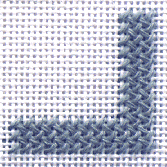
Sample 6 (left) The same soft green
Impressions is used for a border on Zweigart 24 count Congress Cloth, but
only one strand is used. |
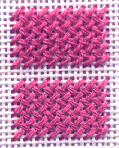
Sample 7 (left) Also on 24 count Congress
Cloth, this sample shows the Woven Stitch worked with one strand of Impressions
#2046 on the top and two plies of Soie Cristale #2046 on the bottom. (Note:
The solid colors of Impressions coordinate with the Soie Cristale silks,
and the hand dyed colors of Impressions coordinate with the other hand
dyed colors in the Caron Collection.) |
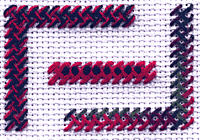  Sample
8 (left) As you have seen, the Woven Stitch can be used in many ways. The
last sample, worked on 14 count Aida, shows three different ways to border
a holiday project. The border on the left is worked with two strands of
Impressions, one of green #5081 and one of red #2071. The stitching in the
middle is worked with two strands of red Impressions for the Woven Stitch,
and one strand of green Impressions for the French Knots. The border on
the right is worked with one ply of Watercolours #025 Holiday Sample
8 (left) As you have seen, the Woven Stitch can be used in many ways. The
last sample, worked on 14 count Aida, shows three different ways to border
a holiday project. The border on the left is worked with two strands of
Impressions, one of green #5081 and one of red #2071. The stitching in the
middle is worked with two strands of red Impressions for the Woven Stitch,
and one strand of green Impressions for the French Knots. The border on
the right is worked with one ply of Watercolours #025 Holiday
|
DESIGNER TIP: Experiment
with your favorite stitches and see how many different ways you can use
them. You will be surprised at how fast your ideas develop! Keep a supply
of index cards handy with your stitching supplies so you can jot down those
ideas as they occur. The cards will serve to remind you of your inspiration
when you're looking for ideas for future projects. Above allrelax and have
fun with your stitching!
Click below if you missed last
month's class.
Using
Variegated Threads for Dramatic Effects
COPYRIGHT NOTICE: No part of these instructions nor the included designs/charts can be reproduced
or distributed in any form (including electronic) or used as a teaching
tool without the prior written permission of KAZ Designs. One time reproduction
privileges provide to our web site visitors for and limited to personal
use only.
|

